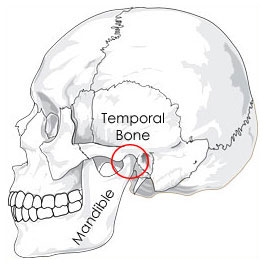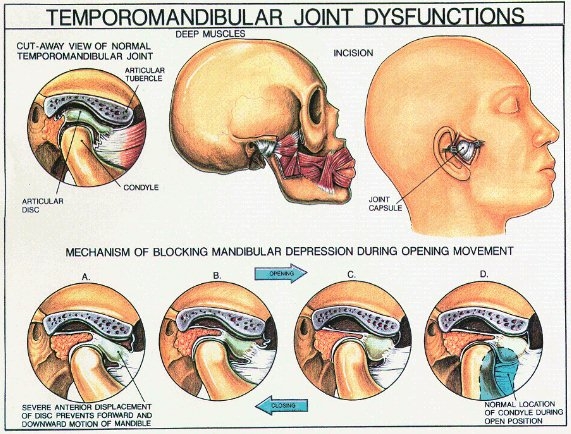Sudden headaches are something everyone deals with from time to time, and it is often a sign that your body is trying to communicate to you through the pain. While the majority of headaches are benign; not having any serious consequence, and are brought on by fairly common circumstances such as lack of sleep or increased stress, they are easily taken care of by oral pain relievers or simply taking some rest. Sometimes, however, a headache can be due to something else entirely, such as is the case with
Temporal Mandibular Joint Dysfunction (TMJD), a pain disorder originating from muscles connecting the
jaw bone (mandibular condyle) to the
temporal bone of the skull.

It’s estimated that about 20-30% of adults between the ages of 20 and 40 years are
affected by TMJD, with the majority of individuals being female. The muscles used to chew food (muscles of mastication) are the main contributors to the pain symptoms seen in this disorder with no real definite cause for its occurrence but have been speculated to be due to many factors such as previous injury, arthritis, or even genetics. Symptoms can affect both sides of the jaw or just one, and may only last temporarily or become chronic lasting years.
Commonly Symptoms of TMJD:
- Pain/Tenderness in Jaw or Face
- Difficulty opening mouth
- Clicking or popping sound of jaw joint
- Difficulty chewing
Symptoms may also manifest as other bodily ailments, as pain in the body can travel to other body parts making the diagnosis of TMJD difficult. This is called “
referred pain” where the pain is felt in a part of the body other than the actual source. Here are some
alternative symptoms that may also be seen with TMJD:
- Toothaches
- Headaches
- Neck aches
- Earaches
- Upper shoulder pain
- Tinnitus (ringing in the ears)
- Dizziness
- Hearing problems
It is often a dentist that makes the
diagnosis of TMJD as many other oral conditions display similar symptoms, such as tooth decay or gum disease. Your dentist will often perform a physical exam, inspecting the jaw muscles and listening for any unusual sounds when opening and closing the mouth. If the dentist feels that further investigation is warranted, he/she may call for an X-ray or more detailed imaging such as a CT or MRI, giving a much clearing depiction of what is happening with the joint, and possibly ruling other any other diagnosis. If still unsure, referral to a specialist may be required.

If you believe that you or someone you know may suffer from temporal mandibular joint dysfunction it is highly recommended to seek out the advice of your local dentist to better understand how to tackle your specific symptoms, here some of the treatment methods employed to combat symptoms.
- Home Therapy: it is important to avoid actions that may flare up the symptoms of TMJD such as clenching or grinding your teeth, investing in a mouth guard may help remedy involuntary grinding. Limiting excessive jaw movement when possible has been shown to benefit patients, as eating soft and non-chewy foods helps reduce muscle spasms and pain.
- Oral Painkillers: NSAIDs (non-steroidal anti-inflammatory drugs) can be found over the counter such as Advil or Tylenol, and are the most common treatment option for TMJD. While they have shown to be effective in controlling mild to moderate pain, prescription pain control medications may be needed for more severe pain.
- Bite Appliances: much like wearing a retainer children use to straighten out their teeth, the Hawley-Type maxillary appliance effectively reduces the pain and discomfort associated with TMJD. Dental occlusal splinting is a similar method that protects the temporal mandibular joint from dysfunctional forces that may lead to negative symptoms by improving the alignment of the upper and lower teeth (occluding splints), or open the jaw, helping relieve muscle tension, and prevent teeth clenching (non-occluding splints).
While in the majority of patients, symptom resolution typically occurs within
2-4 weeks with conservative management alone. For those unfortunate to develop chronic pain syndromes, physical therapy or relaxation therapy is added to the overall management. If still no resolution is achieved psychological pain counselling is recommended, as TMJD symptoms may be a manifestation of stresses in a person’s life. If all else fails, oral surgery may be a more definite option, but currently, has little evidence of long-term effectiveness.

 It’s estimated that about 20-30% of adults between the ages of 20 and 40 years are affected by TMJD, with the majority of individuals being female. The muscles used to chew food (muscles of mastication) are the main contributors to the pain symptoms seen in this disorder with no real definite cause for its occurrence but have been speculated to be due to many factors such as previous injury, arthritis, or even genetics. Symptoms can affect both sides of the jaw or just one, and may only last temporarily or become chronic lasting years.
It’s estimated that about 20-30% of adults between the ages of 20 and 40 years are affected by TMJD, with the majority of individuals being female. The muscles used to chew food (muscles of mastication) are the main contributors to the pain symptoms seen in this disorder with no real definite cause for its occurrence but have been speculated to be due to many factors such as previous injury, arthritis, or even genetics. Symptoms can affect both sides of the jaw or just one, and may only last temporarily or become chronic lasting years.
 If you believe that you or someone you know may suffer from temporal mandibular joint dysfunction it is highly recommended to seek out the advice of your local dentist to better understand how to tackle your specific symptoms, here some of the treatment methods employed to combat symptoms.
If you believe that you or someone you know may suffer from temporal mandibular joint dysfunction it is highly recommended to seek out the advice of your local dentist to better understand how to tackle your specific symptoms, here some of the treatment methods employed to combat symptoms.